Photographs allow us to capture a moment that would otherwise be lost – and fabric and thread offer a way of preserving that moment as textile art.
Originally trained as a photographer, when Joetta Maue snapped a quick image of her young children sleeping, she introduced the under-exposed image to her treasured collection of old domestic linens and allowed the destined pillowcase to present itself. That pillowcase, with its stains and rough edges, gave a platform to the image and, using a projector, Joetta preserved the outlines in simple couched stitch. Left unironed, the wrinkles added to the intimacy and autobiography of the piece.
Joetta’s work has been exhibited in galleries and museums internationally. She explores themes of intimacy, the landscape of the domestic space and the evidence of our daily lives, through drawing and photography.
Her work and critical writing have been featured in numerous books and journals including Fiber Arts Now Magazine, Martha Stewart Living and the Surface Design Association Journal. She is a Lecturer at Northeastern University and Massachusetts College of Art and an invited instructor at a number of programs and institutions across the country. Joetta lives in New England with her family.
In this interview Joetta describes her slow and intuitive practice, her visual influences, and how she reaches her decisions on thread, colour and stitch that lead to her emotive embroideries – in this case, her piece ‘In bed, my loves’.
Name of piece: In bed, my loves…
Year of piece: 2020
Techniques and materials used: approx 40 x 50 inches, embroidery, hand embroidery with linen thread on found pillowcase
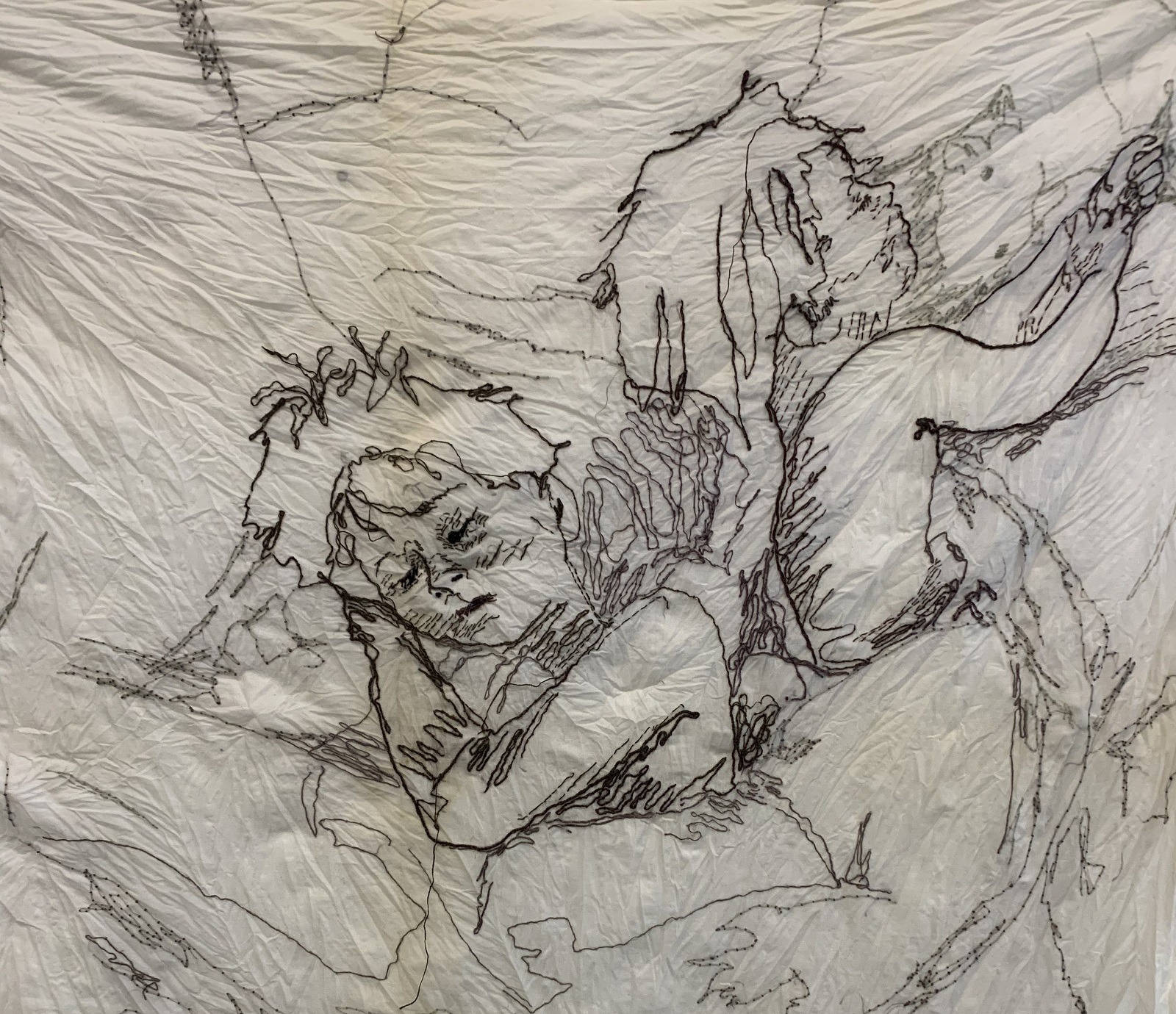
Intimacy, light and autobiography
TextileArtist.org: How did the idea for the piece come about? What was your inspiration?
Joetta Maue: Most of my work just “arrives” to me – either through a photograph that I take or an image “appearing” in my head.
This work was made for an upcoming solo show that I had scheduled at Harvard University. I felt the exhibition “Evidence of Us,” which was an exhibit of drawings, photographs and embroidered works, needed one more embroidery piece to feel balanced between the 3 mediums. As I considered what that embroidery might be, this particular image kept coming back to me.
The source image was a very under-exposed iPhone photo that I took of my children sleeping. The visual balance of their bodies and their curving towards one another called to me as a portrait of their intimacy. Often my drawings with thread come from photographs that I have taken that formally have something really lovely in the composition and are moment-captured – but do not have the light or contrast to work as a photograph itself. Once I had committed to the image it became about how I would execute it.
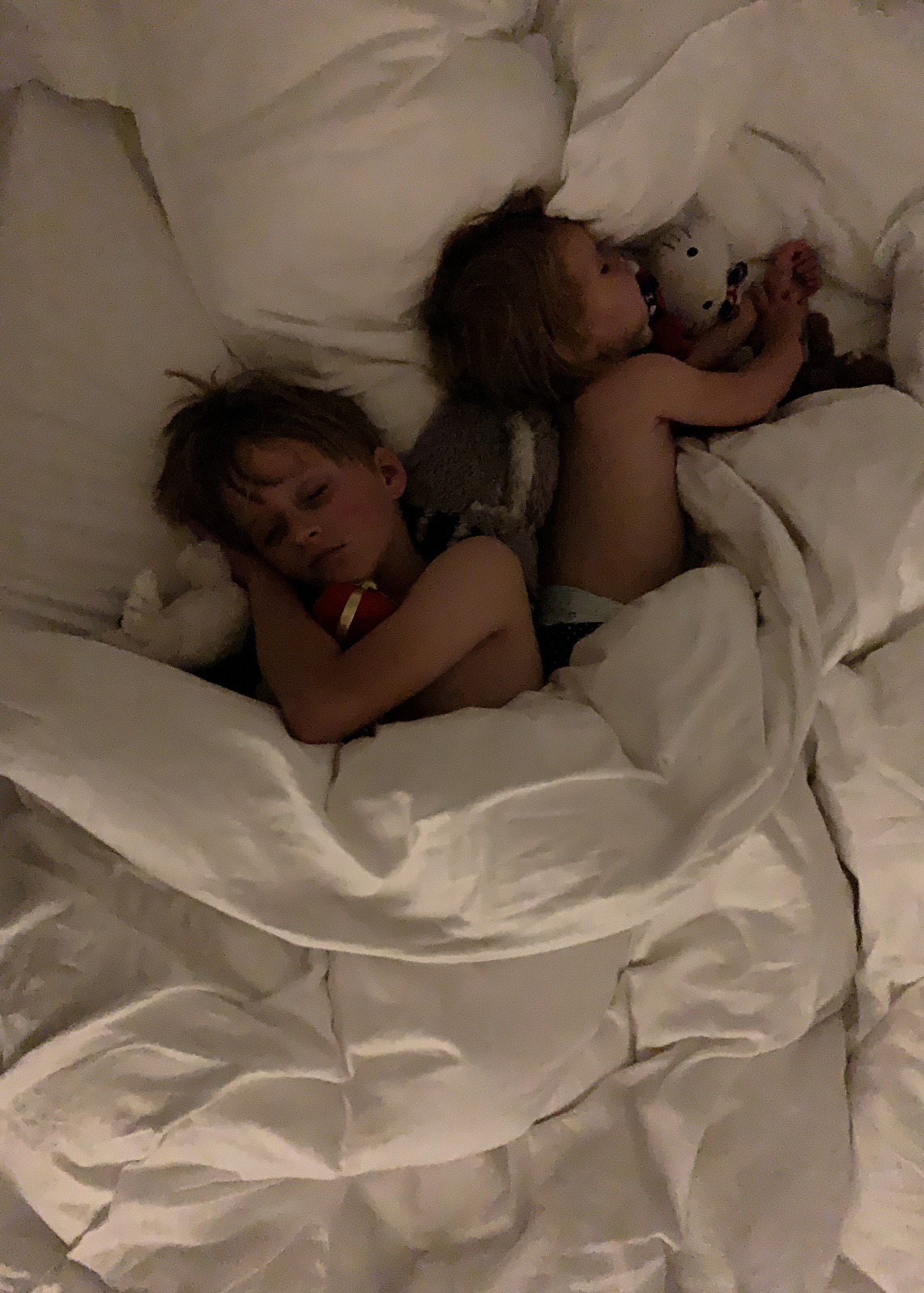
What research did you do before you started to make?
My work always comes from an intuitive studio practice and takes inspiration from my daily life. As a result, I do not really do research for pieces themselves, but I am always researching my general ideas and themes – such as intimacy, light, and the autobiography. This is often in the form of studying poets, writers, artists and philosophers that have explored similar themes.
Technically speaking I am always pushing my work in some way. This development of work is always done through experimentation and play in my studio with my materials and tools.
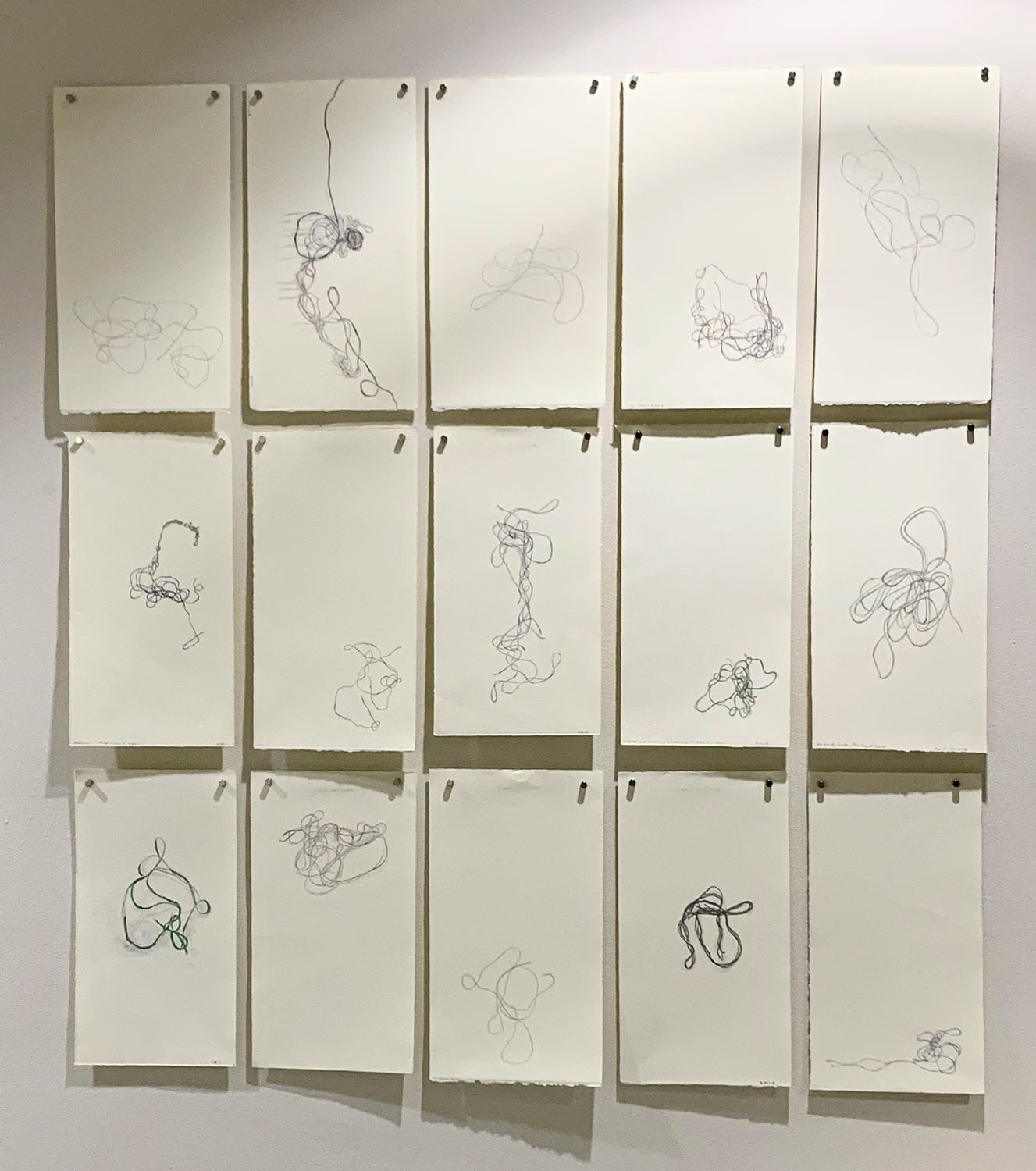
Let the linen speak
Was there any other preparatory work?
Since my work is so time consuming, I do very little prep work as I want to just get to the real thing. With that said, often new shifts in my larger works have been influenced by my small works (where I can be more experimental) and/or samplers that I make while teaching. I find this forces me to get out of my studio patterns and habits.
This work was the first large piece that I have ever done using the couching stitch. This stitch has become one that I teach my students in certain classes, due to its flexibility to follow a highly nuanced line. This ability, and its gestural quality, is why I chose it for this piece and was definitely influenced by my teaching.
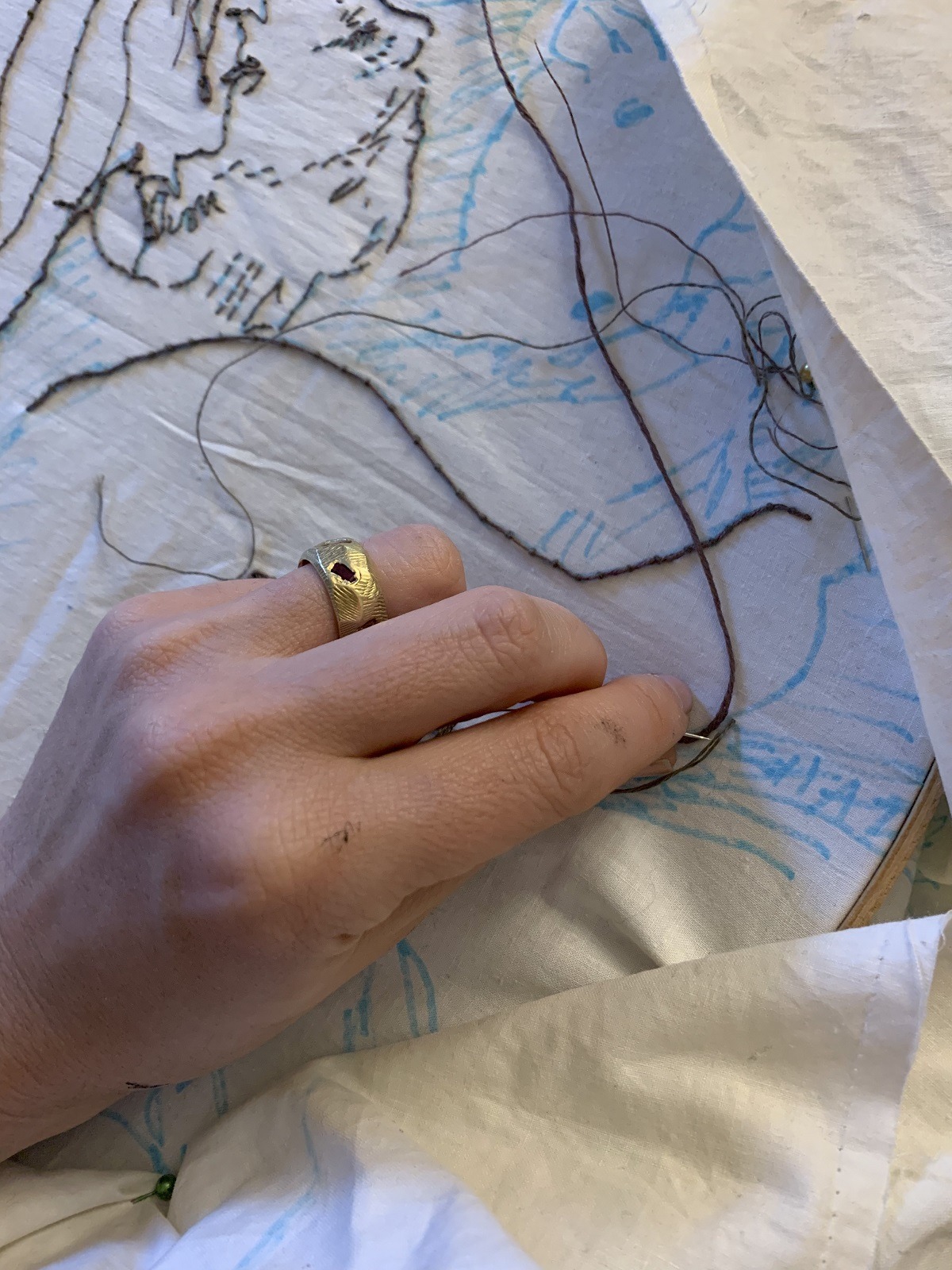
What materials were used in the creation of the piece? How did you select them? Where did you source them?
My materials come to me in many different ways. For textiles, I have a large collection of old domestic linens. These linens have been directly purchased, gifted, found on the road, left for me in schools by past students and dropped off by strangers.
I really need the linen to speak to the image in order for the work to feel ready to be made. It can sometimes be a challenge to find that relationship.
This work was a particular challenge. The image is mostly composed as a square – therefore I needed a linen that was somewhat square in order to keep the balance of the composition that drew me to the image in the first place. However, most square linens are kitchen linens, tablecloths, curtains, etc…
Due to the fact that this photo was taken in a bed, I wanted the linen to speak the language of that space. The pillowcase that I ended up using just kept feeling like the right canvas; it was highly stained, which spoke to the raw intimacy of family and sibling-hood. The embroidered design was unfinished, which felt true to the young relationship of my children and how it is just at its beginning. The embroidered design is two dears together, which seemed perfect for the innocence that my children exhibit.
The problem was that a pillowcase is clearly a rectangle. So in the end I cut the pillowcase open and created the square from its entire shape. The thread I used was specifically purchased for the piece as I had decided that I wanted the piece to be very soft and muted, taking this idea and inspiration from the under-exposed light of the photo. As a result, I did not want to use DMC floss, which I have pretty exclusively used in my work before, due to its slight sheen. I found this linen yarn at a speciality shop and really liked the palette. The yarn was much too thick for my work so I unravelled it by hand to a much finer thread.
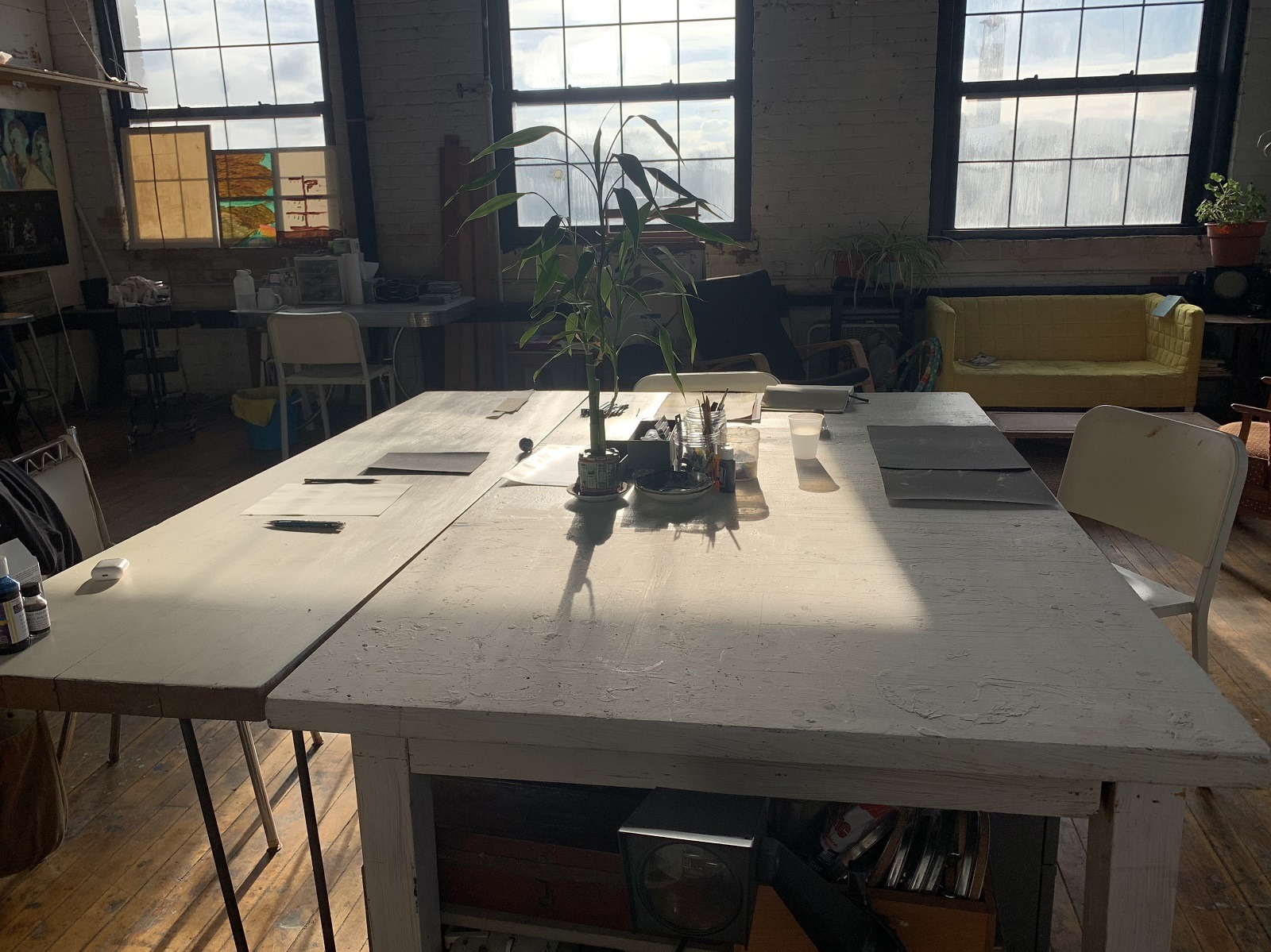
Gestural and expressive couching
Take us through the creation of the piece stage by stage
Once the linen and image have been found, the next stage is for me to project the image onto the linen. This often takes a bit of time to compose as I am really interested in the balance of space. I think a lot about how the white space of a piece exists and the edges of the image. Since I am trained as a photographer, I tend to crop differently than artists who were trained as painters or in more traditional mediums.
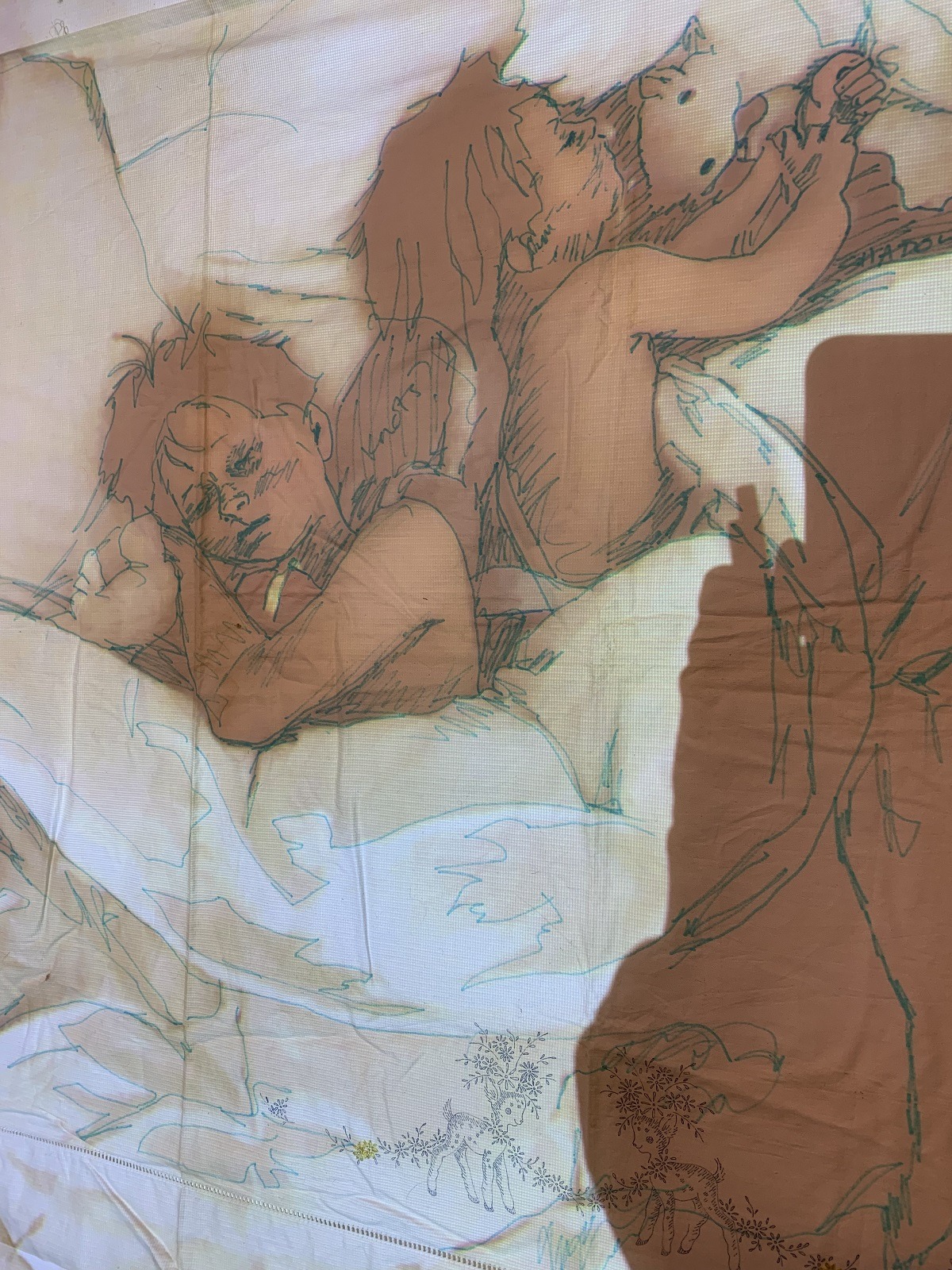
Once the composition has been found, I draw the entire image from the projection with a water soluble marker. I have thicker and thinner tips to help with the detail areas vs the long gestural lines. This drawing can take an hour or two as this is when I really capture the shapes of the subject and the sense of light. In this particular image the light was very dark so the contours and shadows were very soft. I really wanted to capture that in the drawing; as a result the drawing was much more loose than most of my work.
Once the drawing is done, I decide on thread, color and stitch. As mentioned, I chose a linen yarn that I unraveled. I wanted the drawing to be subdued in tone but not entirely monochromatic so I ended up deciding on blue-grays and purple-grays as the final color palette. The gestural and loose quality that the drawing had did not lend itself to the vocabulary of stitches that I had been relying on previously. I also was concerned that, since the thread was thicker, some stitch choices would not work. I ended up doing the piece with the couching stitch as it has the ability to be more gestural and expressive, as well as not complicating the thicker thread.
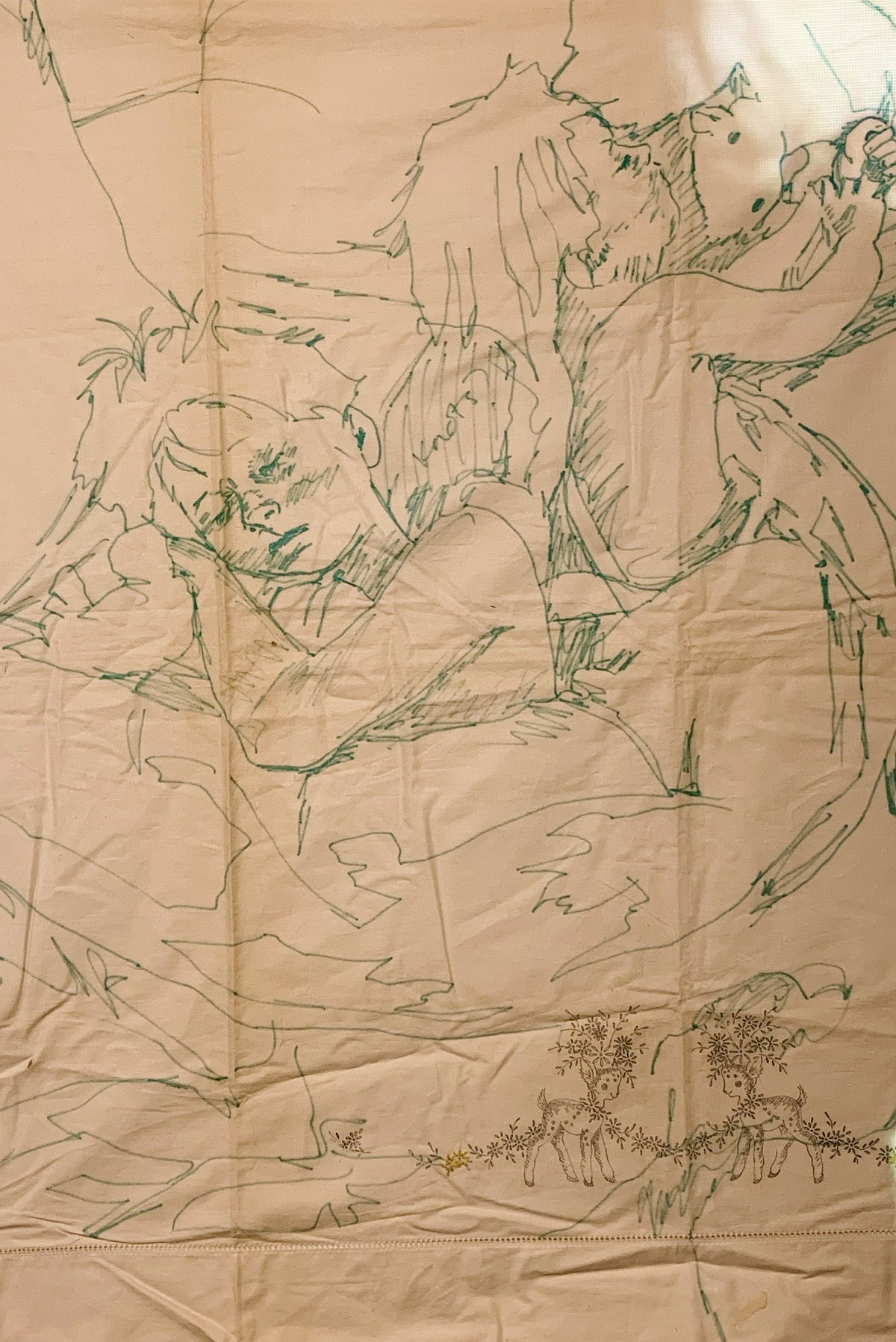
I also chose to leave the ripped raw edge of the pillowcase unfinished; there was something more open in the work with it this way. I really wanted the work to feel light and relaxed and warm, so I needed to avoid formal choices that might overly contain the work.
Once all these decisions are made, I stitch. I work intuitively deciding on thread count adjustments, line adjustments and drawing shifts. Always referring to the source image but also the emotion the source image captures as well as brings out in me.
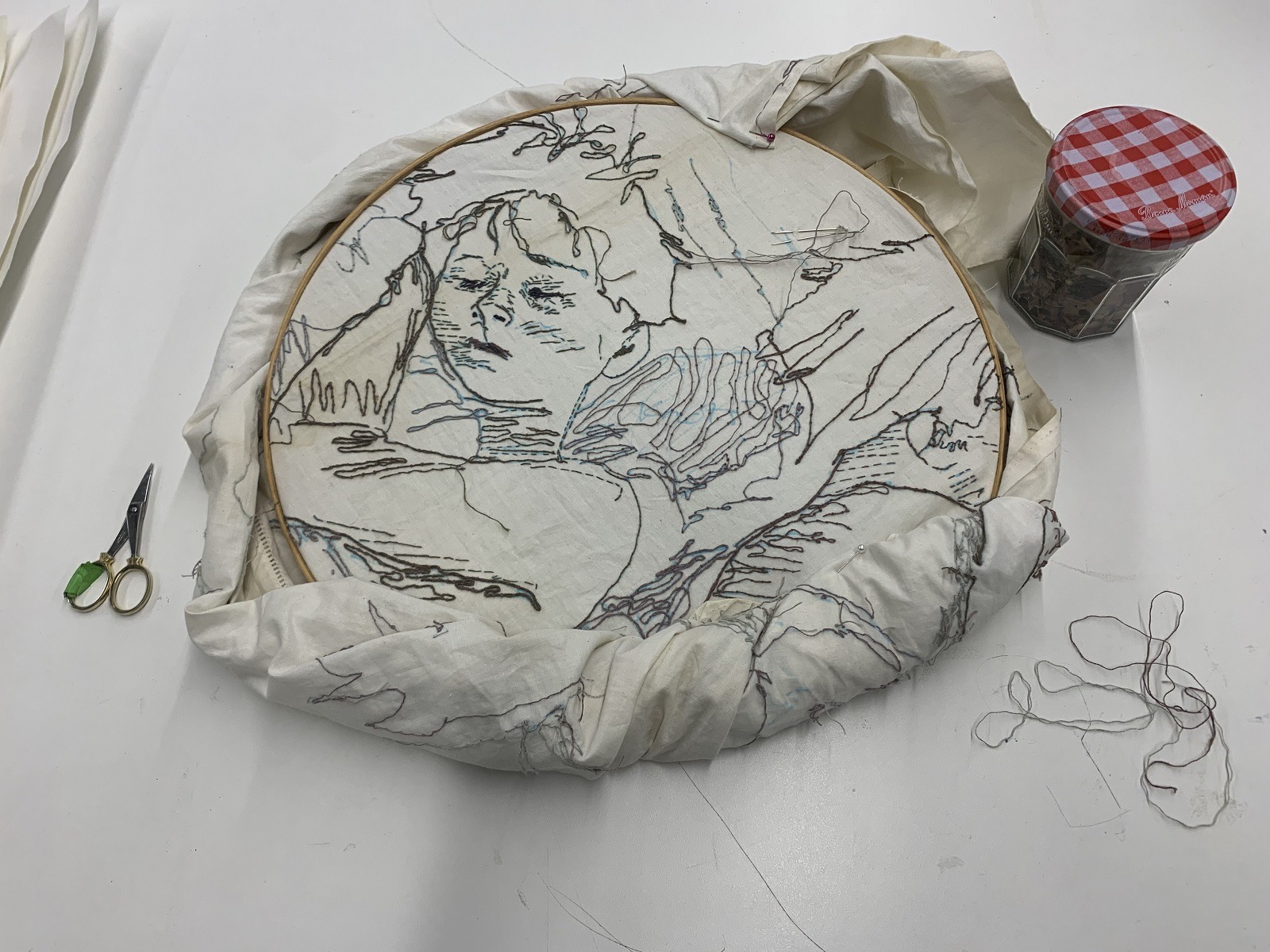
While working for hours on the stitching I often listen to podcasts, a favorite is On Being and various poetry readings and artist interviews. Occasionally I listen to music, and often I just sit with my thoughts and stitch. Slowly, stitch by stitch the work comes into being.
This piece was washed and hung, as all my pieces are, once completed. The wrinkles that formed in its drying added so much visually to the sense of a rumpled bed, tired body, soft breath and the essence of skin touching one another, that I ultimately left it unironed.
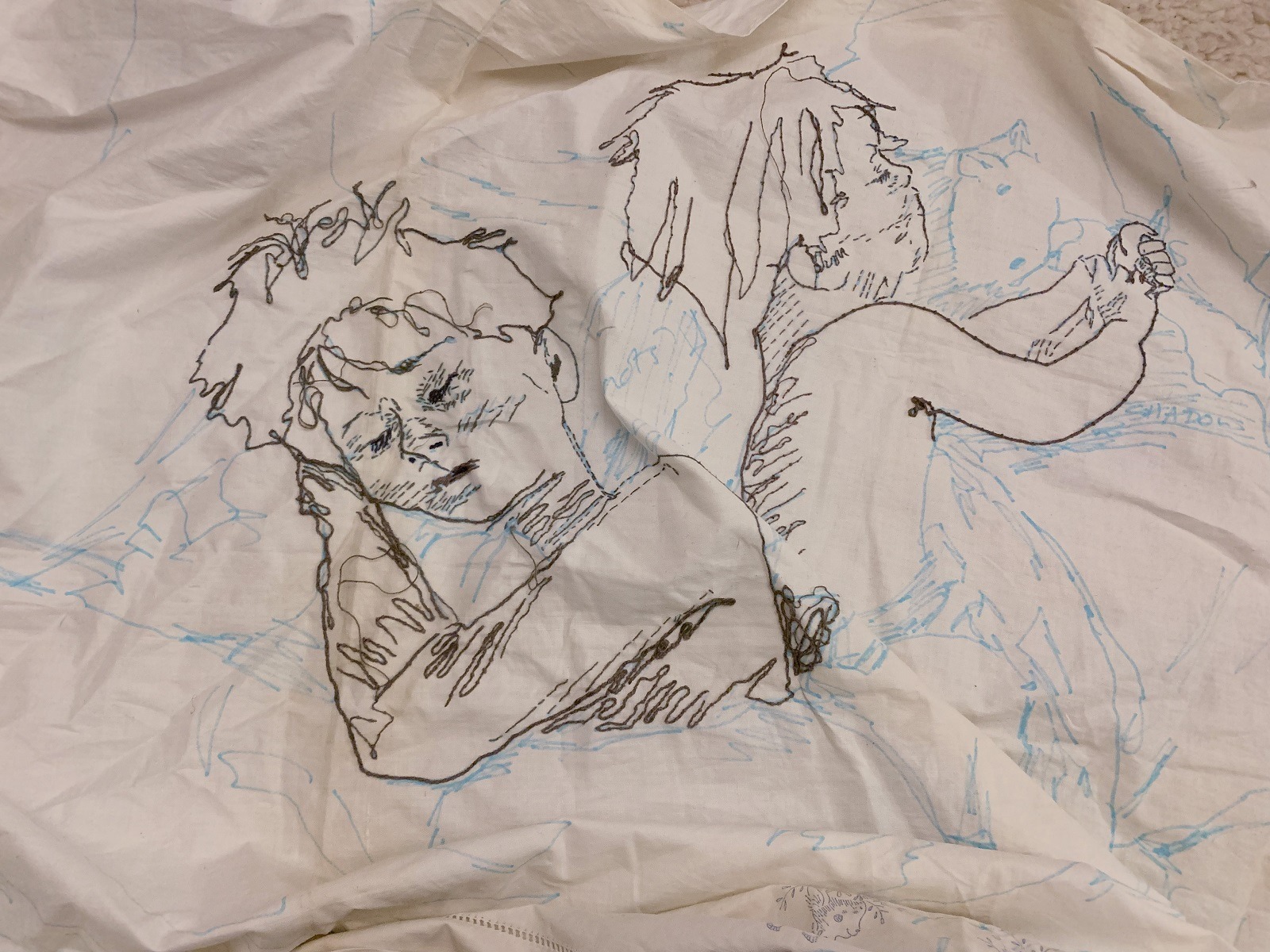
What journey has the piece been on since its creation?
The piece was primarily made in my studio, which is a large open space in a foam factory in Somerville, MA. It also traveled with me to Penland in NC where I do their winter residency; this is where I actually finished the stitching. It was then hung as part of my exhibition that was installed the first week of March 2020.
The exhibit was seen for roughly 10 days before Harvard was shut down for COVID. The work sat in a silent, quiet, dark space for roughly five months before I was able to retrieve it – mostly unseen. Due to the lack of in-person exhibitions, I have chosen to limit my exhibiting until they resume. So my piece sits gently rolled in my studio waiting to be seen again – very much like myself.
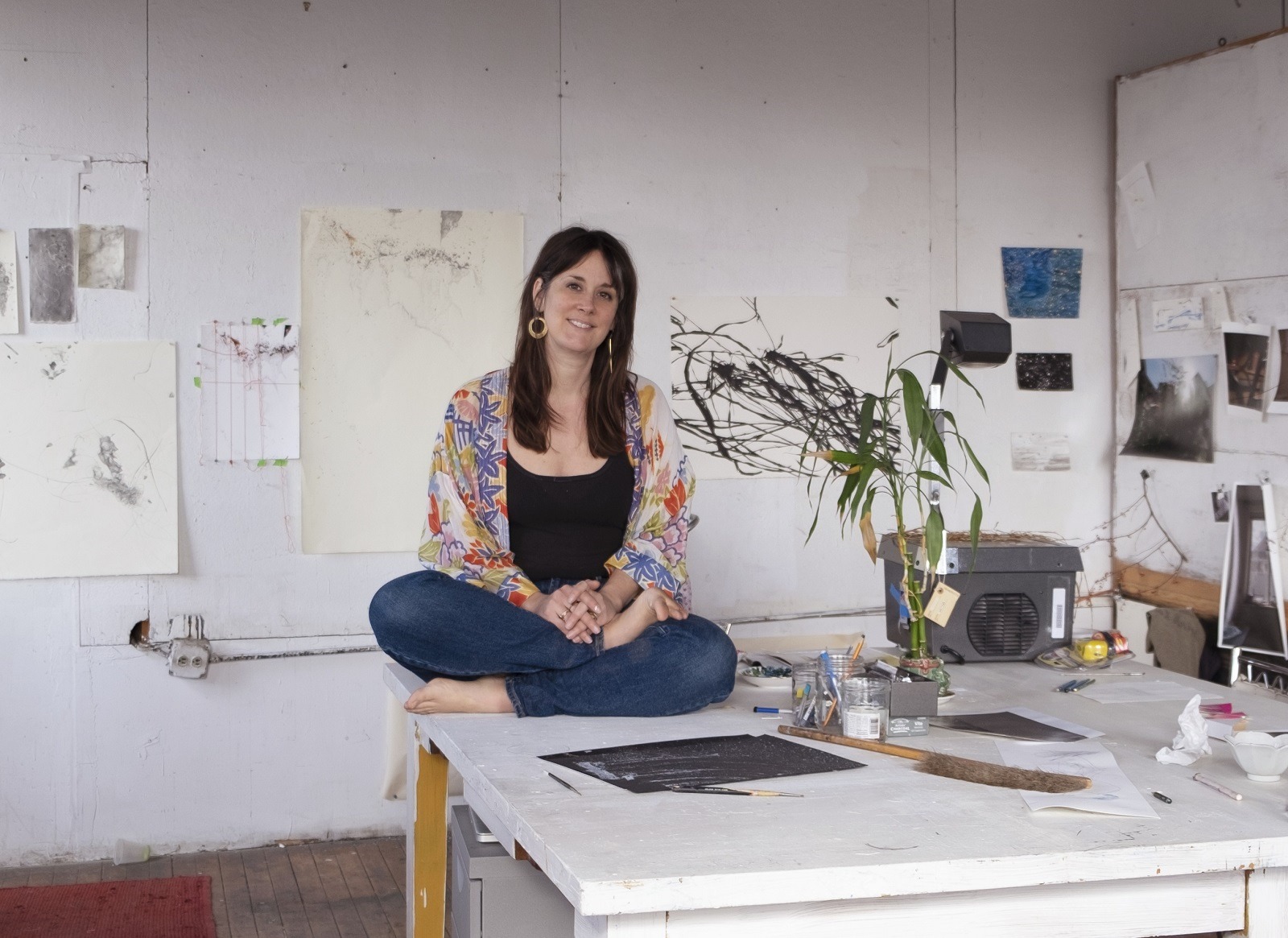
For more information visit www.joettamaue.com
Joetta has delved deep into her thoughts and intuitive process. What touched you most from her description? Please let us know in the comments below.
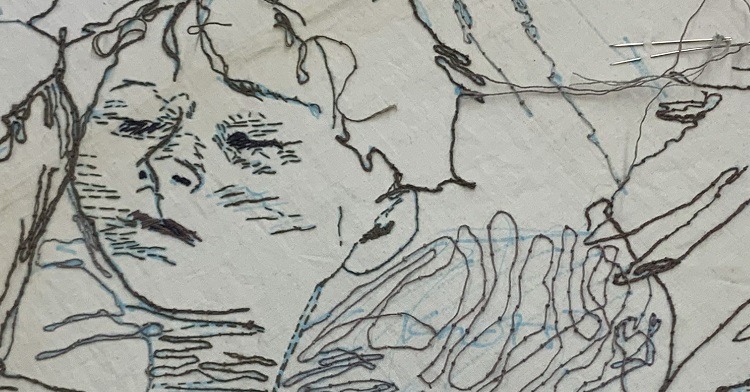

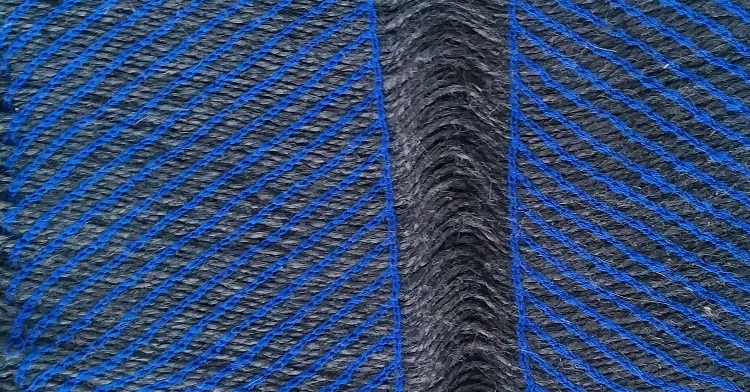
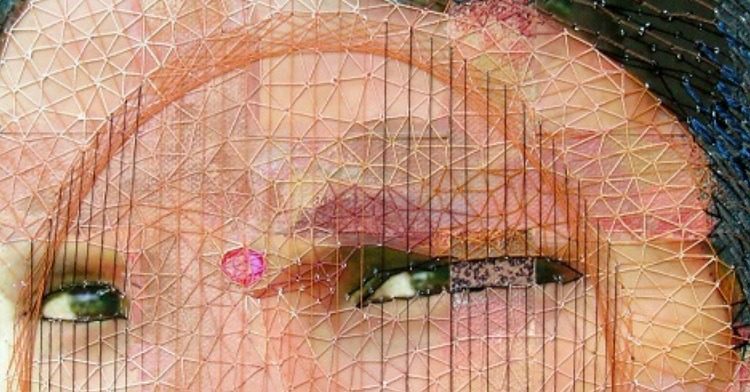
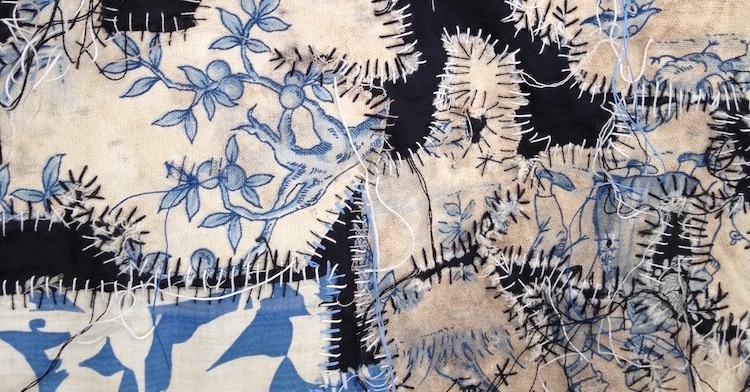
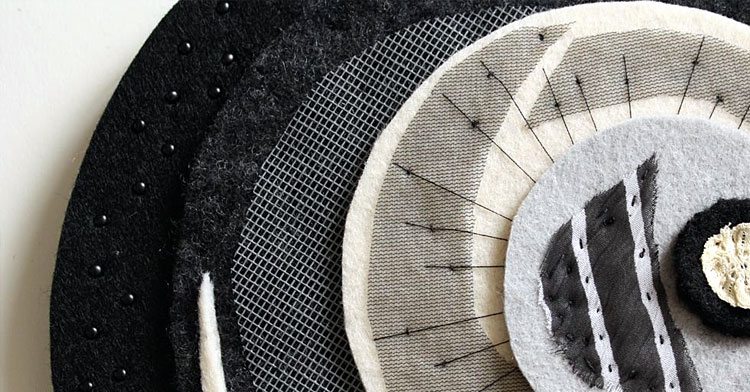
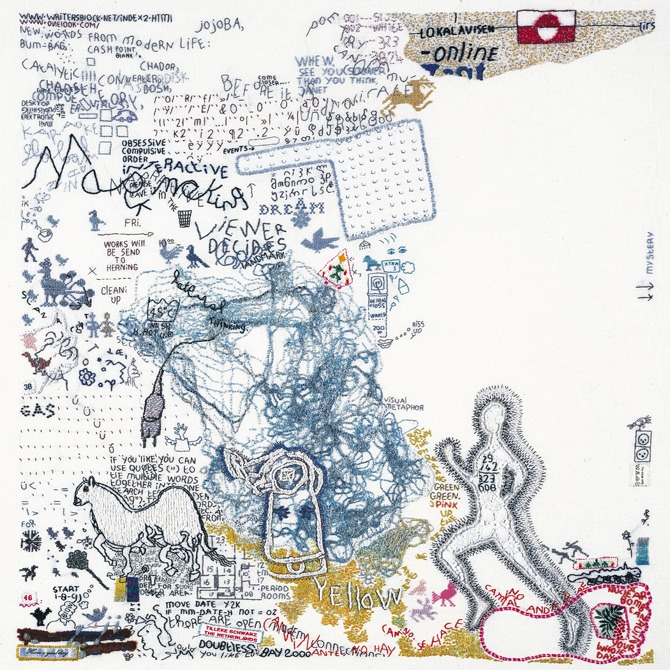
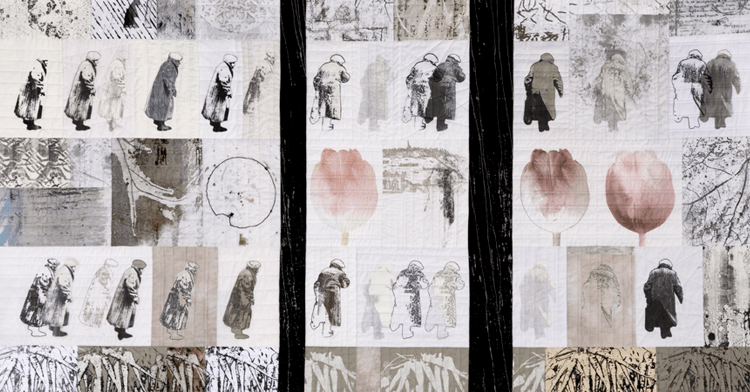
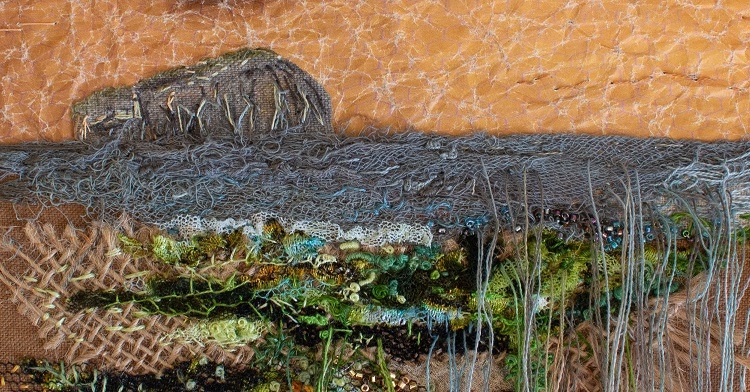
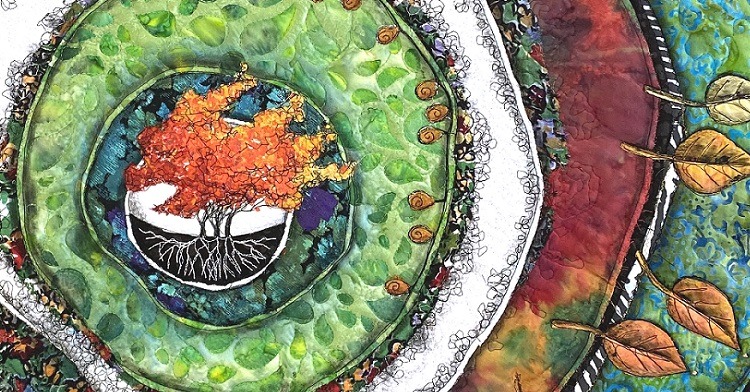
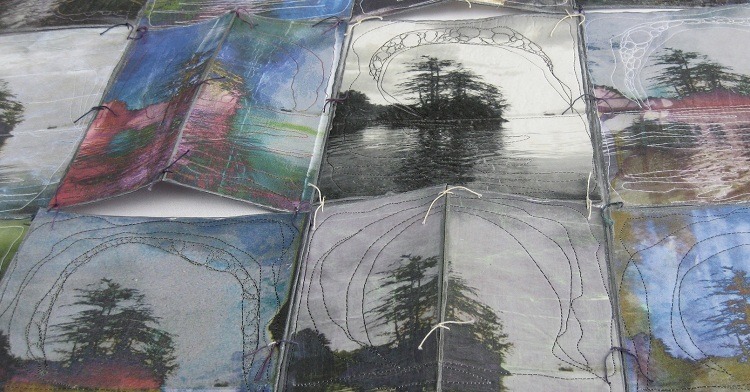
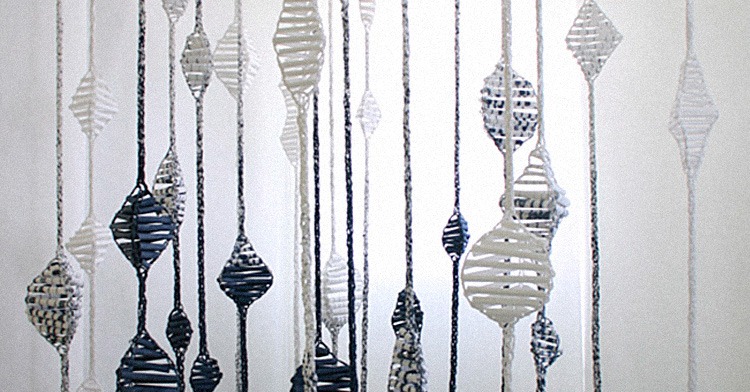
7 comments
jerry reei
nice
Vanessa Isom
When I saw this piece of Joetta’s work, I felt a real tug of emotion. For I had seen that image so many times of my two younger sons, a year apart in age, when they would always get into each others bed to sleep. They are now older with homes of their own, one to be married in two weeks, and the other in four months, but that bond is still there and they are the best of friends. Your work is beautiful Joetta, and what a wonderful way to capture that moment in time. I look forward to trying to do the same.
Banella
Sometimes the way I work, what is in my head instead of on paper. Yes, I too like to just and stitch with my thoughts.
angela.j.harding@gmail.com
How amazing!!i
i have JUST taken a photo of (my very lovely) granddaughter ….all ready to stitch and rather ‘struggling’ as to how to begin…so your thoughts and description is so timely…
I have second granddaughter..both names begin with E and I was planning on creating a duo…
Now truly inspired! Thank you!
Here’s hoping!!
Angela
Jeanne
I’ve had the opportunity to take several classes with Joetta…always inspires. Beautiful work.
Maria Sêco
I loved the choice of the pillow cover, perfect for the subject, the “relaxed” tone of the piece and the sensation it gave me of entering a private world and being allowed to share a soft and endearing moment.
Chris
Loved this piece. So intimate and filled with emotion.
Was good to hear that her inspiration just comes to her as a “picture”. This is how I work and always find it hard to explain to people that this happens. Never tried projecting an image though.